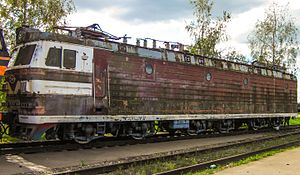SŽD series ВЛ86Ф
| SŽD series ВЛ86 Ф (WL86 F ) | |
|---|---|
|
WL86 F .001
|
|
| Numbering: | SŽD ВЛ86 Ф .001 |
| Number: | 1 |
| Manufacturer: | mech. Electric locomotive factory Nowotscherkassk el. Oy Strömberg AB |
| Year of construction (s): | 1985 |
| Retirement: | 2015 |
| Axis formula : | Bo'Bo'Bo '+ Bo'Bo'Bo' |
| Gauge : | 1,520 mm |
| Length over coupling: | 45,000 mm |
| Bogie axle base: | 2,900 mm |
| Smallest bef. Radius: | 125 m (at 10 km / h) |
| Service mass: | 300 t |
| Friction mass: | 300 t |
| Wheel set mass : | 25 t |
| Top speed: | 110 km / h |
| Hourly output : | 11,400 kW |
| Continuous output : | 10,800 kW |
| Driving wheel diameter: | 1,320 mm |
| Power system : | 25 kV 50 Hz ~ |
| Power transmission: | Three-phase drive technology |
| Number of traction motors: | 12 |
The SŽD series ВЛ86 Ф (German transcription WL86 F ) of the Soviet Railways (SŽD) was a twelve-axle freight train - electric locomotive . It was developed from the ВЛ85 , the difference to this locomotive was the equipment with three-phase drive technology for corresponding traction motors. This was also shown by the index Ф ( F ) in the designation, which should indicate phase current transmission. For many years it was considered the most powerful locomotive in the world. Only one copy was built in 1985 and it was used for experimental purposes. The reasons for the non-serial production were various technical causes and the difficult economic situation in the former USSR . With the appearance of the RŽD series 4ЭС5К the machine was taken out of service.
prehistory
The first attempt to use locomotives with three-phase drive technology was made as early as the 1960s. In 1967 the Novotscherkassk electric locomotive factory delivered the test locomotive WL80.238 , in which one of its sections was equipped with a model with eight-pole three-phase traction motors named ЭТА-1200 ( ETA-1200 ) with an output of 1,200 kW per motor. The section had stepped high-voltage regulation of the voltage. The power was transmitted via an alternating current converter with a rectifier and a three-phase inverter to generate the three-phase current to the traction motors. The construction and various inspections revealed various shortcomings. In 1971 a locomotive with three-phase AC traction motors was delivered with the WL80 A .751 . In the mechanical part, the locomotive consisted of components from the WL80 with the exception of the three-phase traction motors with the designation НБ-602 ( NB-602 ) and an output of 1,200 kW per traction motor. In comparison with the model section, the output voltage of this locomotive was not regulated in steps. The conversion of the alternating current into direct current was carried out in the same way as in the model section. At the time, the conversion into three-phase current for the traction motors was still incomplete.
Creation of the new locomotive ВЛ86 Ф
In the early 1980s, with the creation of electric locomotives by the semiconductor industry, there were very different ways of transmitting electricity. At that time, electronic converters were already being used in the ВЛ80 P electric locomotive and were producing positive results from operation. As a result, the production of locomotives with three-phase drive technology was resumed at the Novotscherkassk electric locomotive factory. Initially, the project planning was done in two versions of a 12-axle electric locomotive. It was soon agreed on a work plan in which the current transmission was carried out as before by rectifying the current from the contact network, the conversion of direct current into three-phase current of the traction motors was replaced by a four-quadrant controller . The execution was undertaken similar to the locomotives of the series 120 of the DB . The production of this four-quadrant actuator and the other electrical equipment were carried out by the Finnish company Oy Strömberg AB , with which the Novotscherkassk electric locomotive factory already produced the VR series Sr1 of the Finnish State Railways . At the end of 1985, the production of the new electric locomotive was completed and it was given the designation ВЛ86 Ф .001 .
Fate of the locomotive
Due to the difficult financial situation of the former SŽD and some other reasons, there was no series production after the delivery of the locomotive, the machine remained a test locomotive for three-phase drive technology and was used on the track ring in Scherbinka . The locomotive stayed there for about 30 years. Currently, section A of the locomotive is being scrapped at the Novocherkassk electric locomotive factory, section B is still on the territory of the All-Russian Research Institute for Rail Transport .
List of locomotive giants
- SŽD series ВЛ85 - this twelve-axle two-section locomotive for alternating current with an hourly output of up to 10,020 kW stands for the most powerful electric locomotive in the world with mass production.
- MTAB IORE from LKAB Malmtrafik AB is also a twelve-axle two-section freight train electric locomotive with an hourly output of 10,800 kW, but this locomotive has three-axle bogies.
- RŽD class 4ЭC5К - this sixteen- axle four-section locomotive for alternating current is currently the most powerful locomotive in the world with an hourly output of 13,120 kW.
See also
literature
- WA Rakow experimental freight train electric locomotive Wl 86 Ф // Locomotives and multiple units of the railways of the Soviet Union 1976–1985. - Ministry of Transport, 1990. - Pages 29-31. ISBN 5-277-00933-7 .
